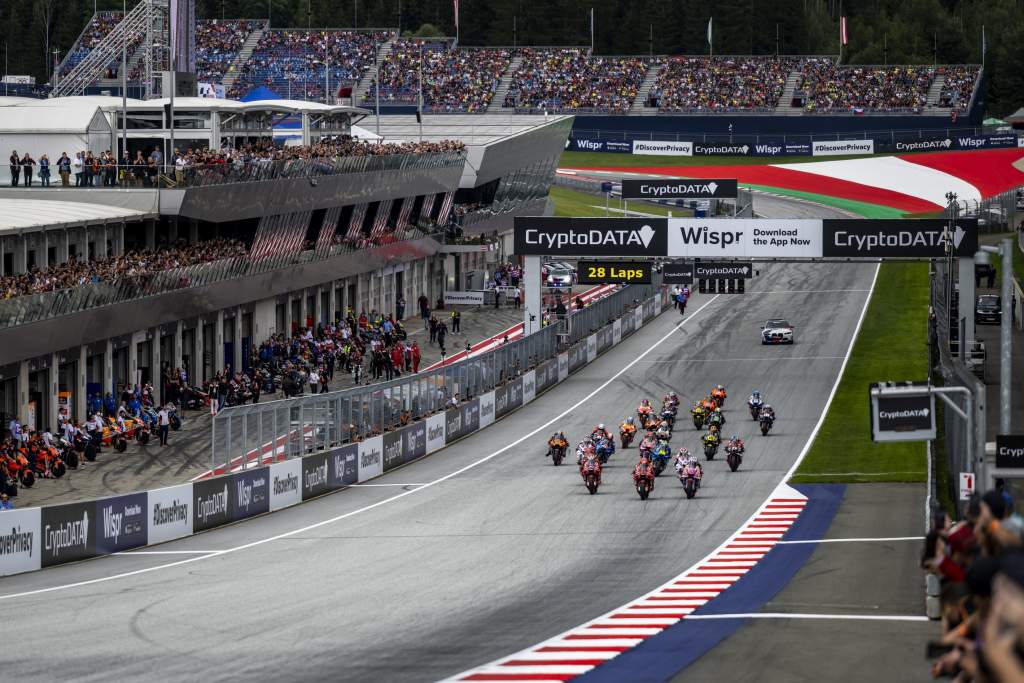MotoGP’s control tyre manufacturer Michelin will roll out its new front tyre later this year for the first tests aimed not just a riders’ feeling but to fix what has become a fundamental problem in the series that has led to widespread claims of boring racing thanks in large parts to issues concerning on the front end of the bike.
The new tyre will first be used by the series’ official test riders in October, the first step in the long process (the planned timespan exacerbated by the limited amount of testing time for MotoGP’s racers) of rolling out the whole new construction for the 2024 season – the earliest possible time that the new design can be introduced.
Michelin’s bosses are subsequently hoping to see their new construction trialled by the race riders at the one-day Valencia test which follows the final round of the championship in November.
The introduction of the new tyre can’t come soon enough, because while the series might be trying to counter the fall in audience numbers with gimmicks like the introduction of sprint races, one of the fundamental problems that the championship is currently facing isn’t a lack of races on the calendar: it’s the fact that, in recent years, the series has become comparatively lacklustre in terms of on-track action.

Very much the selling point of MotoGP as recently as 2019, since then things have gone in the opposite direction, with races rarely being decided on the last lap in the way they were when we saw first Andrea Dovizioso and then Fabio Quartararo able to spar with Marc Marquez on a regular basis.
That’s not, of course, to say that the blame lies with Michelin. Instead, it’s a direct effect of the way in which MotoGP development has done a complete about-face in recent years, becoming, perhaps for the first time ever, not about building a bike for the control tyres but instead about trying to make the tyre work on whatever Frankenstein’s monster the engineers roll out.
“When you have a control-tyre championship, then the manufacturers have to design their motorcycles around the tyres,” Michelin bike racing boss Piero Taramasso told Motorsport Magazine at the weekend. “But by adding all the aero and the devices, then they aren’t designing their motorcycles around the tyres.”
And, with the use of aerodynamics and ride height devices altering not just the shape of the bikes but how they act and the forces they put on the front tyre, the result has been obvious: increased front pressures, overheating tyres and, as a result, no confidence from riders permanently on the limit to really push for passes.
It’s complicated even further by the massive amount of heat generated by MotoGP machines, this making the front temperature issues exponentially worse for those who have to follow riders – an issue which makes overtaking even harder.
Therefore, the only solution to bringing back some of the sport’s unique selling point is to rush Michelin’s new front tyre onto the grid as soon as possible, hence the desire to see riders on it in October of this year, even if the full development process is expected to take a further year after that.

In the interim, however, there is a temporary solution that Michelin hopes to introduce for next year- safely lowering the mandatory minimum tyre pressures that teams are allowed to run.
With this emerging as a talking point earlier this year when it was revealed that the vast majority of the grid are already on occasion under the limit – driven by the sensitivity of Michelin’s tyres and the effect that setting up your bike for a pack race and then finding yourself out alone can have – it didn’t prompt any sanctions at the time as teams still negotiate a spec for a standardised tyre pressure sensor.
However, according to the French brand, it believes that it can in part avoid that issue in 2023 (when sensors are set to be mandatory) by lowering the minimum pressure and giving riders and teams a little more flexibility in finding a set-up that allows them to push.
“I’d like to say that next year go can go to 1.8 or 1.7 bar with the tyre we use at the moment,” revealed Taramasso. “But we cannot go lower than this. When we started using this tyre fives years ago the minimum pressure was 2.1 bar, then we went to 2.0 and then to 1.9.”



